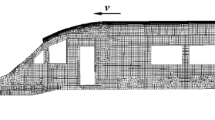Abstract
This paper proposes a procedure to improve the design of an automobile crashworthiness using the deceleration pulse in a simplified form as a design variable. A complete vehicle in a full frontal crash was simulated to find its deceleration pulse by finite element method. Based on this deceleration pulse, sled tests were performed, also in a virtual environment. Comparisons between the real deceleration pulse and a simplified pulse were made based on the HIC15 produced. The simplified pulse is developed by dividing the pulse in three phases, each with a constant level of deceleration. Simulations were made to minimize the HIC15 changing parameters in the restraint system and in the deceleration pulse. An expression was found to relate HIC15 and the first phase of the deceleration pulse. A design case using this expression is presented. The benefits of using the pulse as a design variable along with the restraint system are accounted.
Similar content being viewed by others
References
Cao, J. Z., Koka, M. R. and Law, S. E. (2004). Vehicle pulse shape optimization to improve occupant response in front impact. CAE Methods for Vehicle Crashworthiness and Occupant Safety, and Safety-Critical Systems. Warrendale, SAE, 71–77.
Chen, X. and Li, B. (2009). Crashworthiness and massreduction design of vehicles based on enhanced RSM. 5th IEEE Vehicle Power and Propulsion Conf., VPPC’ 09, Dearborn, MI, USA. 1755.
Consolazio, G. R., Chung, J. H. and Gurley, K. R. (2003). Impact simulation and full scale crash testing of a low profile concrete work zone barrier. Computers and Structures 81, 13, 1359–1374.
Du Bois, P., Chou, C. C., Fileta, B. B., Khalil, T. B., King, A. I., Mahmood, H. F., Mertz, H. J. and Wismans, J. (2004). Vehicle Crashworthiness and Occupant Protection. American Iron and Steel Institute. Southfield. Michigan. http://www.autosteel.org/~/media/Files/Autosteel/Research/Safety/safety_book.ashx
Eren, I., Gür, Y. and Aksoy, Z. (2009). Finite element analysis of collapse of front side rails with new types of crush initiators. Int. J. Automotive Technology 10, 4, 451–457.
EURONCAP (2011). http://www.euroncap.com/tests/frontimpact.aspx
Fang, H., Rais-Rohani, M., Liu, Z. and Horstemeyer, M. F. (2005). A comparative study of metamodeling methods for multiobjective crashworthiness optimization. Computers and Structures 83, 25–26, 2121–2136.
Goel, T. and Stander, N. (2009). Comparing three error criteria for selecting radial basis function network topology. Computer Methods in Applied Mechanics and Engineering, 198, 27–29, 2137–2150.
Griffiths, M., Paine, M. and Haley, J. (1999). Consumer crash tests: the elusive best practice. Symp. Worldwide Harmonization of Crash Test Programs, Cologne, Germany. http://users.tpg.com.au/users/mpaine/ncap_tuv.html
Hamza, K. and Saitou, K. (2005). Vehicle crashworthiness design via a surrogate model ensemble and a coevolutionary genetic algorithm. Proc. ASME Int. Design Engineering Technical Conf. and Computers and Information in Engineering Conf., Long Beach, USA. 899.
Hamza, K. T. (2008). Design for Vehicle Structural Crashworthiness via Crash Mode Matching. Ph. D. Dissertation. The University of Michigan.
Hilmann, J., Paas, M., Haenschke, A. and Vietor, T. (2007). Automatic concept model generation for optimisation and robust design of passenger cars. Advances in Engineering Software, 38, 11–12, 795–801.
Hu, S., Ma, Z.-D., Qi, C. and Hu, P. (2009). Magic cube approach application on crashworthiness design of front rail in front angle impact. 2009 IEEE Int. Conf. Mechatronics and Automation, ICMA 2009, Changchun, China. 3521.
Huang, M. (2002). Vehicle Crash Mechanics. CRC Press. Boca Raton. Fla.
Insurance Institute for Highway Safety (2009). Frontal Offset Crashworthiness Evaluation Guidelines for Rating Injury Measures.
Kawabe, Y., Kondo, T., Masuda, D., Mogi, T., Obayashi, K. and Okabe, T. (2004). Restraint system optimization for dual test configurations of frontal crashes. CAE Methods for Vehicle Crashworthiness and Occupant Safety, and Safety-Critical Systems. Warrendale, SAE, 79–90.
Lee, S. I., Lee, D. C., Lee, J. I., Han, C. S. and Hedrick, K. (2007). Integrated process for structural-topological configuration design of weight-reduced vehicle components. Finite Elements in Analysis and Design 43, 8, 620–629.
Macey, S. and Wardle, G. (2009). H-Point: The Fundamentals of Car Design & Packaging. 1st edn. Design Studio Press (2009). Culver City. CA.
McHenry, B. G. (2004). Head Injury Criterion and the ATB. ATB User’s Group. http://www.mchenrysoftware.com/HIC%20and%20the%20ATB.pdf
NCAC (2006). Finite Element Model of Dodge Neon. FHWA/NHTSA National Crash Analysis Center. Version 7. http://www.ncac.gwu.edu/vml/archive/ncac/vehicle/neon-0.7.pdf
NHTSA (2008). http://edocket.access.gpo.gov/cfr_2008/octqtr/pdf/49cfr571.208.pdf
Opiela, K. (2010). Finite Element Model Archive. http://www.ncac.gwu.edu/vml/models.html
Patel, N. M. (2007). Crashworthiness Design using Topology Optimization. Ph. D. Dissertation. University of Notre Dame.
Qi, C. (2008). A Magic Cube Approach for Crashworthiness and Blast Protection Designs of Structural and Material Systems. Ph. D. Dissertation. The University of Michigan.
Shi, Y., Zhu, P., Shen, L. and Lin, Z. (2007). Lightweight design of automotive front side rails with TWB concept. Thin-Walled Structures 45, 1, 8–14.
Solanki, K., Oglesby, D. L., Burton, C. L., Fang, H. and Horstemeyer, M. F. (2004). Crashworthiness simulations comparing PAM-CRASH and LS-DYNA. CAE Methods for Vehicle Crashworthiness and Occupant Safety, and Safety-Critical Systems. Warrendale, SAE, 11–19.
Witteman, W. (1999). Improved Vehicle Crashworthiness Design by Control of the Energy Absorption for Different Collision Situations. Technische Universiteit Eindhoven.
Witteman, W. (2005). Adaptive frontal structure design to achieve optimal deceleration pulses. The 19th Int. Technical Conf. Enhanced Safety of Vehicles (ESV), Washington D.C., USA. NHTSA. 1–8.
Wu, H. and Xin, Y. (2009). Optimal design of the S-Rail for crashworthiness analysis. Proc. 2009 Int. Joint Conf. Computational Sciences and Optimization, CSO 2009, Sanya, Hainan, China. IEEE Computer Society 2009, 735.
Xu, T., Li, Y., Li, Q., Hao, L. and Song, W. (2010). Crashworthiness design of frontal rail using strainenergy-density and topology optimization approach. 3rd Int. Joint Conf. Computational Sciences and Optimization, CSO 2010: Theoretical Development and Engineering Practice, Huangshan Mountain, Anhui, China. 24.
Yannaccone, J. R., Whitman, G. R. and Sicher, L. (2005). Pretensioners and injury risk. Proc. — Annual SAFE Symp. Survival and Flight Equipment Association, 63.
Author information
Authors and Affiliations
Corresponding author
Rights and permissions
About this article
Cite this article
Urbina, P., Orta, P. & Ahuett-Garza, H. Crashworthiness design based on a simplified deceleration pulse. Int.J Automot. Technol. 15, 909–917 (2014). https://doi.org/10.1007/s12239-014-0095-6
Received:
Revised:
Accepted:
Published:
Issue Date:
DOI: https://doi.org/10.1007/s12239-014-0095-6




